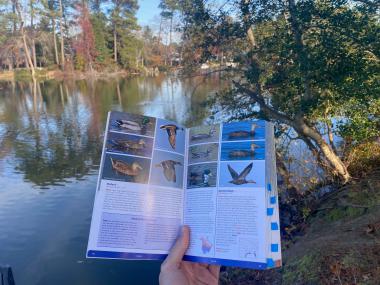Written by Brantley Bissette, HRSD Community Education and Outreach Specialist Published on December 15, 2023
We’re already thick into the holiday season, and although gifts for loved ones are already piling up under trees, tucked away in closets or crammed into mailboxes, the hunt for those last-minute gifts continues for many of us. In fact, one of my favorite family traditions is the annual Christmas Eve shopping frenzy at the mall (by family, I mean me, my dad and brother – mom is always one step ahead!).
While exchanging gifts is one of the hallmarks of the festive season, this mass movement of products takes a heavy toll on the environment. From the carbon emissions caused by planes, ships, and trucks to the continuous buildup of landfills and inescapable side-effect of plastic pollution, every swipe of the credit card during the holidays affects more than just our wallets. However, we can minimize our impact to the environment while simultaneously educating loved ones and inspiring a collective interest in sustainability by looking towards more eco-friendly gifts.
When you’re braving the crowds at the mall or juggling one too many tabs on your computer as the gift exchange quickly approaches, consider some of these ideas to make the holidays more festive, not just for us, but for the wildlife and landscapes around us.
For the coffee lover in your life

These days, the reusable travel coffee mug and water bottle have become personal accessories as essential as one’s car keys, wallet, cell phone and earbuds. Brands have taken up an arms race to create the trendiest, most durable drinkware. A coffee tumbler, mug or thermos makes a perfect gift for any coffee lover in your life. In addition to doing a better job of keeping their morning brew hot (or cold!) for as long as desired, this gift encourages home-brewed coffee, which helps avoid the daily coffee shop run and eliminates a sizeable chunk of paper or plastic waste.
ECO-TIP: According to Forbes, over 2.5 million acres of biodiverse Central American rainforest has been cleared for coffee bushes, which grow faster under direct sunlight. This has become yet another challenge for the thousands of native and migratory bird species who inhabit the region. To combat this trend, sustainable coffee farms have left rainforest canopies intact, allowing the coffee bushes to grow in a more natural setting and the birds to coexist. Today, several bird-friendly coffee varieties can be found on grocery store shelves. If you’ve decided on a travel coffee mug as a present for the holidays, consider pairing it with a bag of bird-friendly coffee to make your gift doubly green.
Second-hand clothes and books
To mitigate the well-chronicled but oft overlooked environmental impacts of “fast fashion” and rampant paper production, consider checking out your local consignment or thrift store for high-quality, gently used clothing, books, furniture and more.
Used books have become a go-to gift for me, as they are often in pristine condition and can range from just fifty cents at the nearest thrift to half-off original price at a used bookstore. I’ve found everything from trending autobiographies to familiar science fiction titles in my searches around town. Some used bookstores have buyback programs – for the avid bookworm in your circle, leave a receipt or store-branded bookmark in their new read so they can find their way to the store when they’re ready to trade in for new titles!
ECO-TIP: Field guides are a staple at used bookstores and thrift stores. More recent editions offer the most up-to-date science and are generally in great shape, ready for use at the closest park or nature trail. Older publications, on the other hand, may need to stay at home, but can serve as collector’s items or even sophisticated display pieces.

Another second-hand gift to consider is clothing. Fast fashion is known to be disastrous to the environment and leads to clothes of a lesser quality. In contrast, gently-worn clothing found at thrift or consignment stores often hails from reputable brands that are proven to stand the test of time.
Admittedly, perhaps the biggest roadblock with this gift is the stigma of “cheapness.” I think that this is an outdated perspective. In the face of both inflation and simultaneous climate and biodiversity crises, I see consignment gifts as an incredibly responsible alternative. Furthermore, you can often find unique pieces that are either no longer on store shelves (retro is “in” these days, after all) or items that otherwise would be too expensive to add to your shopping cart. Because they don’t put as large of a dent in the wallet, thrifted clothes can make for great white elephant gift exchange prizes, or a good “extra” gift to someone you’ve already splurged on.
-
When we think about the value of gifts, I believe we need to add a sustainability component. We can’t physically see the emissions curbed or trees spared by used books, or the birds benefitting from sustainable coffee, but we can share this message with our loved ones to add that much more value into the gift we thoughtfully sought out for them. This holiday season, let’s celebrate friends and family, the spirit of giving, and the gift that is the natural world around us.